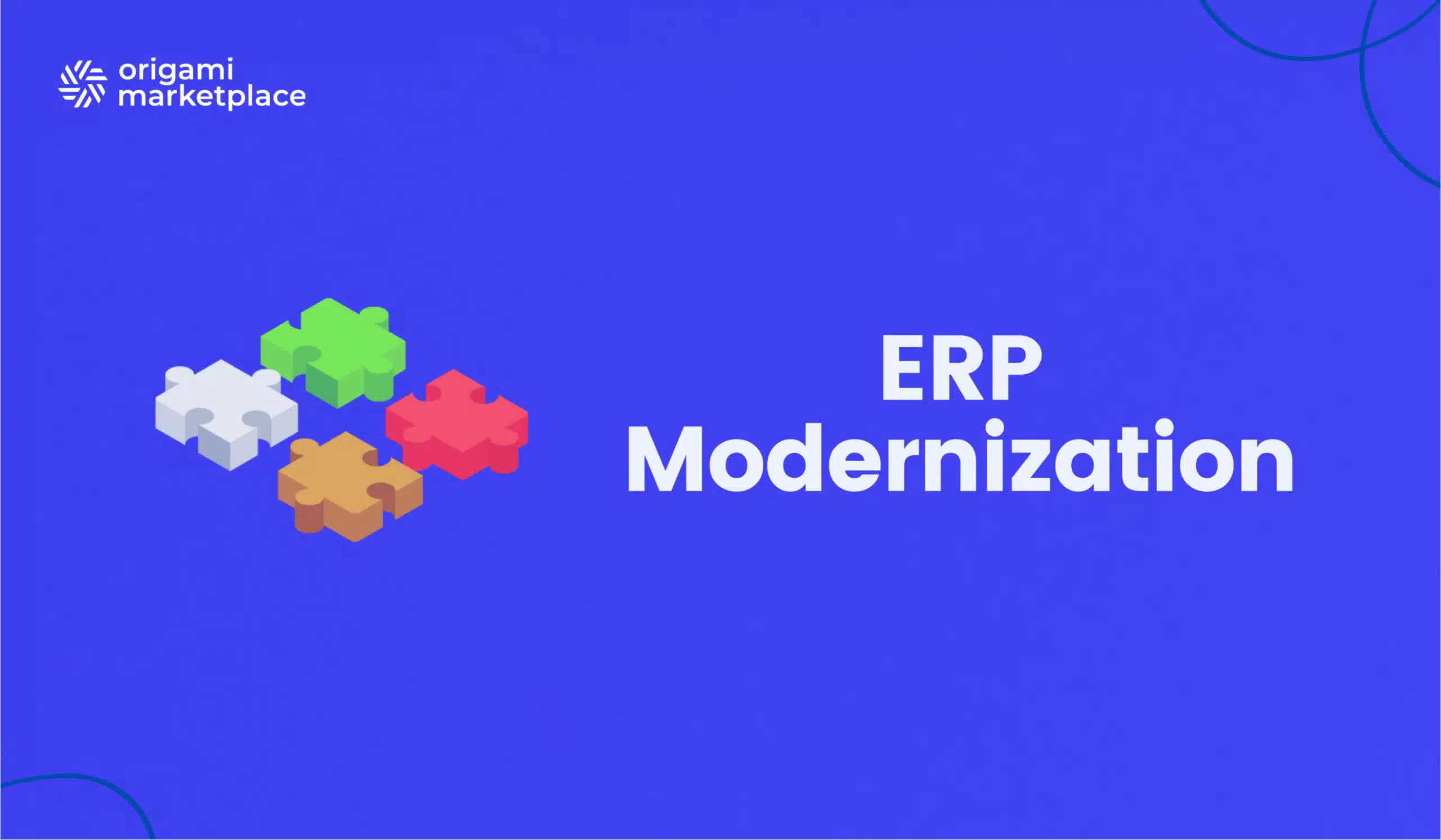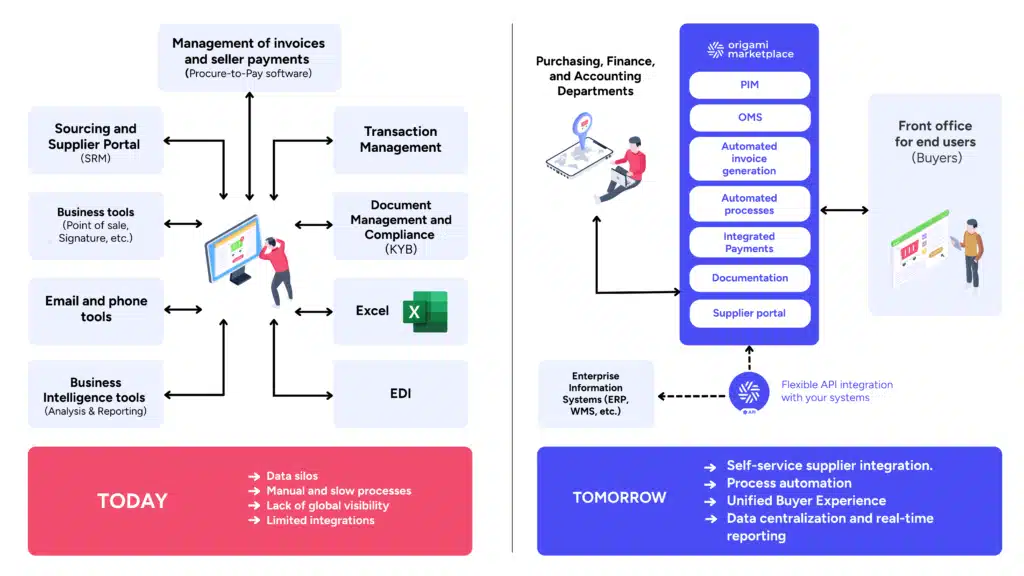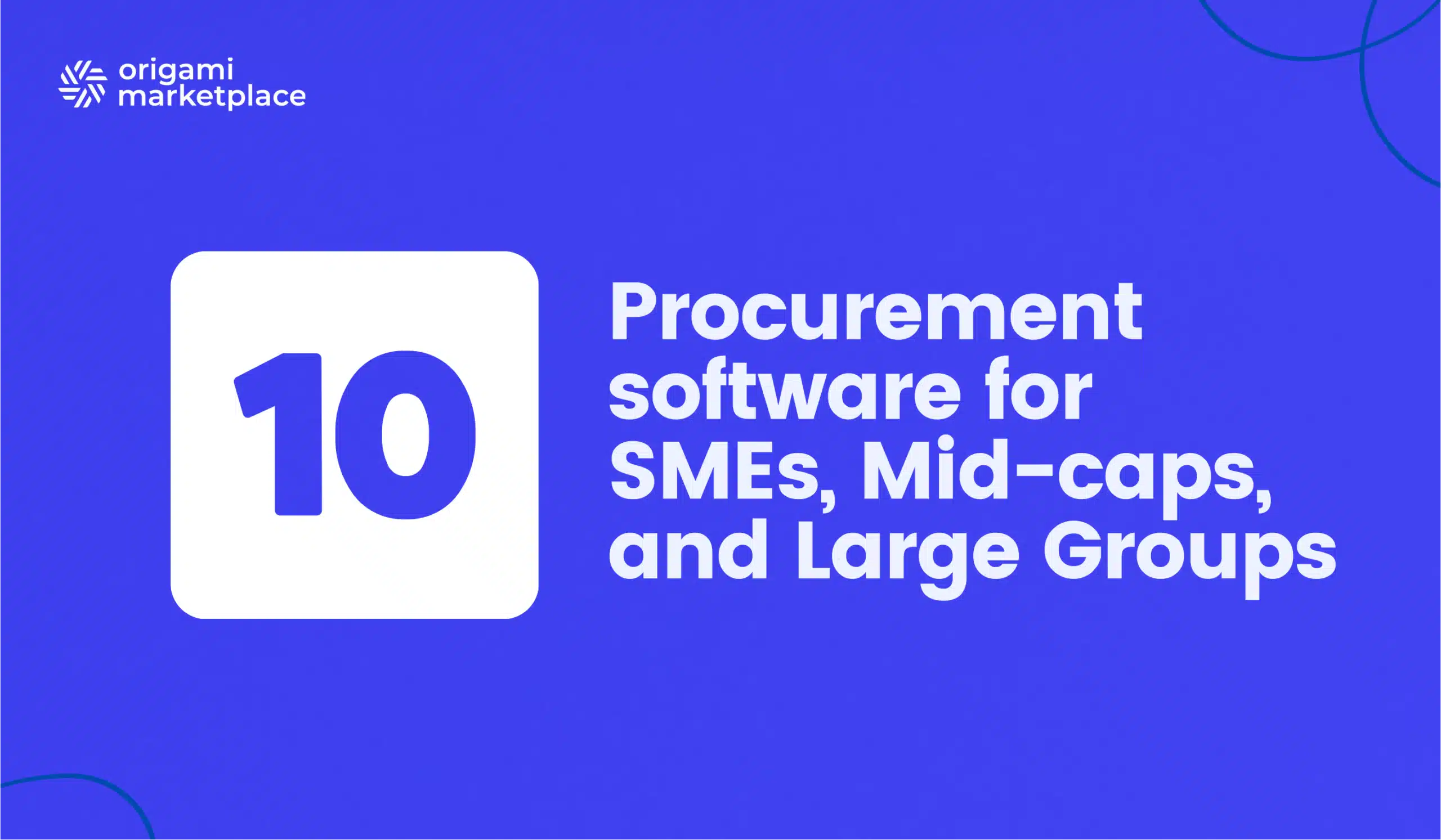ERP Modernization: The guide from Strategy to Execution
- Arnaud
- 12-minute read

Enterprise Resource Planning (ERP) systems have become the central pillar of business operations. However, many existing ERP systems, often called legacy systems, struggle to keep pace with technological innovation and market demands. Modernizing these systems is no longer an option but a strategic imperative for companies wishing to maintain their competitiveness, optimize costs, and drive growth. This guide, crafted by the Origami Marketplace team, explores the challenges, benefits, and strategies of ERP modernization, supported by reliable data and analysis.
TABLE OF CONTENTS:
- What is legacy ERP modernization?
- The limitations and shortcomings of a legacy ERP
- What is a modern ERP and what are its benefits?
- Comparison chart: Legacy ERP vs. Modern ERP
- Real-world use cases by industry
- Strategies for modernizing an axisting ERP
- A comparison of ERP modernization approaches
- A 5-Step action plan to modernize your ERP
- The API-First approach: A winning strategy
- The marketplace model: A popular alternative
- Conclusion: A strategic investment
1. What is legacy ERP modernization?
What is a legacy ERP system?
A legacy ERP system is a software solution that was implemented several years, or even decades, ago. These systems were often designed with a monolithic architecture and proprietary databases, making them rigid and difficult to integrate with third-party applications. While they may have performed well in their time, they now represent significant technical debt that hinders agility and innovation.
Characteristics of existing ERP systems
Legacy ERP systems share several common traits:
- Rigid architecture: Modifications and updates are complex and costly.
- Outdated technology: Leading to compatibility issues and a shortage of maintenance skills.
- On-premise deployment: Requiring significant investments in hardware and staff.
- Unintuitive user interface: Negatively impacting employee productivity and user experience.
Ready to transform your ERP with an API-First solution?
To help you develop the best platform possible, we’ve gathered all the must-have features, key technical considerations, and best practices in a comprehensive document:
Download the Specifications template 🗒
Perfect for smaller or medium-scale projects without a formal purchasing process. It will help you outline your requirements effectively and streamline your selection process.
Download the Request for Proposal template 📒
Ideal for larger, more complex marketplace projects with a formal purchasing department or advanced procurement policies.
2. The limitations and shortcomings of a legacy ERP
The flaws of legacy ERPs directly impact business performance. One of the main limitations is their high maintenance cost. Companies can spend up to 80% of their IT budget on maintaining these aging systems. This situation is critical, as Gartner reports that 45% of CIOs are looking to reduce their investments in legacy infrastructure.
Furthermore, they suffer from a critical lack of agility and flexibility. Their monolithic architecture hinders integration with modern tools (e-commerce, AI, etc.). Security is another major concern, as outdated systems are more vulnerable to cyberattacks.
3. What is a modern ERP and what are its benefits?
A modern ERP stands out with its flexible architecture (often based on microservices), cloud-based deployment, and its ability to easily integrate with other systems via APIs (Application Programming Interfaces). Solutions like SAP S/4HANA, Oracle ERP Cloud, and Microsoft Dynamics 365 exemplify this new generation, designed to be agile, scalable, and user-centric.
Benefits of a modern ERP:
- Increased agility and flexibility: A modular architecture allows companies to add or modify features quickly.
- Significant reduction in operational costs: Migrating to the cloud reduces expenses on infrastructure, maintenance, and updates.
- Improved productivity and efficiency: Intuitive interfaces, mobile access, and automation free up employees from repetitive tasks.
- Enhanced data security: Modern ERP providers invest heavily in security and compliance.
- Innovation and Digital Transformation: Integrating technologies like AI and IoT opens up new business models.
4. Comparison chart: Legacy ERP vs. Modern ERP
| Feature | Legacy ERP | Modern ERP |
|---|---|---|
| Architecture | Monolithic, rigid | Modular, microservices, flexible |
| Deployment | Primarily on-premise | Primarily cloud (SaaS), hybrid |
| Cost | High maintenance costs (OPEX) | Optimized TCO, reduced CAPEX |
| Agility/Flexibility | Low, difficult to adapt | High, easy to adapt and scale |
| Integration | Complex, costly, limited | Easy via APIs, open ecosystem |
| Technology | Outdated, proprietary | Up-to-date, open source, AI, ML, IoT |
| Updates | Infrequent, complex, disruptive | Frequent, automatic, seamless |
| Security | Vulnerable, company-dependent | Enhanced, provider-managed, compliant |
| User Experience | Complex, unintuitive | Intuitive, user-friendly, mobile-first |
5. Real-world use cases by industry
To better understand the impact of a modern ERP, here are a few examples:
- Retail and e-commerce: A retail company can use a modern ERP to synchronize inventory in real-time across its e-commerce site, marketplace, and physical stores. This prevents stockouts, improves the customer experience, and optimizes order management.
- Manufacturing and production: A manufacturer can integrate IoT sensors into its production machinery. Data is sent in real-time to the modern ERP, which uses AI algorithms to schedule predictive maintenance, reducing unplanned downtime and repair costs.
- Logistics and supply chain: A transportation company uses its modern ERP to offer complete, real-time tracking of goods to its customers. APIs make it easy to connect the systems of carriers, warehouses, and end customers for end-to-end visibility.
Feeling inspired by these examples? That's natural. The secret to a successful modernization isn't choosing a technical strategy upfront, but answering one simple question: "What is THE single operational pain point that is holding back our growth the most today?" By focusing on this specific issue, you ensure a quick return on investment (ROI) and build positive momentum for the rest of the project.

Alexandre Duquenoy
→ Discuss your project with our expert
6. Strategies for modernizing an axisting ERP
There are several approaches to modernizing an ERP:
- Full replacement (Big Bang): Risky but fast, this approach involves replacing the entire old system at once.
- Phased rollout: Less disruptive, this involves migrating ERP modules or functionalities in stages, allowing for controlled change management.
- Hybrid approach: Keep parts of the legacy ERP (e.g., finance) while integrating new cloud solutions for other needs (e.g., CRM, supply chain management).
7. A comparison of ERP modernization approaches
Choosing a modernization solution is not just about features, but about strategic philosophy. Here is a comparison of the main approaches on the market.
The Integrated ERP Suites:
These solutions offer a single, comprehensive platform designed to cover all of a company’s needs.
- SAP S/4HANA: The undisputed leader for very large enterprises, especially in manufacturing and production. Its strength lies in its functional depth and robust, standardized processes.
- Oracle ERP Cloud (or NetSuite): Historically strong in finance and data management, Oracle offers powerful cloud solutions for large enterprises and SMBs.
- Microsoft Dynamics 365: The key advantage of this solution is its native integration with the Microsoft ecosystem (Office 365, Power BI, Azure, Teams).
The “Composable” or Marketplace Approach:
This philosophy favors flexibility by building a system from the best-of-breed solutions connected via APIs.
- Origami Marketplace: Rather than a single suite, Origami Marketplace provides a platform to build a “composable” ERP ecosystem. A company can leverage its existing ERP and connect best-in-class software modules for its other needs (sourcing, e-commerce, etc.).
| Approach | Solution(s) | Model | Primary Target | Key Advantages | Points to Watch | Key Modules |
|---|---|---|---|---|---|---|
| Integrated Suite | SAP S/4HANA, Oracle ERP Cloud, Microsoft D365 | Single, comprehensive platform | Large enterprises, Mid-market | Functional depth, standardized processes, single vendor | High cost, rigidity, migration complexity, vendor lock-in | / |
| Composable / Marketplace | Origami Marketplace | Ecosystem of connected "best-of-breed" solutions | SMEs, Mid-market, and large enterprises seeking agility | Maximum flexibility, agility, controlled costs, rapid innovation, no lock-in | Requires governance to orchestrate the different solutions, dependency on API quality | OMS, PIM, etc. |
8. A 5-Step action plan to modernize your ERP
Moving from thought to action requires a clear methodology. Here is a 5-step process to structure your modernization project, which is particularly crucial for launching a B2B e-commerce initiative connected to your ERP.
🔹 Step 1: Audit Your Current Systems & Data
First, accurately assess the capabilities and limitations of your current system. The goal is to identify the friction points that are slowing down your operations. Ask the right questions:
- Data management: Where do you have manual data entry, inaccuracies, or information silos?
- System strain: What workarounds or custom patches are overloading your ERP beyond its original purpose?
- Critical processes: Which transactions regularly fail? Where are the bottlenecks?
- Unmet needs: What business requirements can your current ERP simply not handle?
🔹 Step 2: Define the Target Architecture (Headless & API-First)
Your technical vision must be clear: decouple the back-end from the front-end. Your ERP is your back-end system of record; it should not be your front-end sales interface. The goal is to implement a “headless” architecture where the two systems communicate via an API layer, fully embodying the API-First approach.
🔹 Step 3: Choose the Right Approach (Suite, Marketplace, or Hybrid)
Based on your audit and vision, you can now evaluate market solutions. An integrated suite will replace much of your existing system, while a marketplace approach like Origami Marketplace will allow you to evolve it by connecting the best-of-breed modules you need.
🔹 Step 4: Prioritize the Rollout
Focus first on the area most affected by data inaccuracies often inventory or order management. By migrating this process to a modern, headless solution, you will achieve quick, tangible, and visible wins.
🔹 Step 5: Manage the Implementation (Test, Train, Secure)
A modernization project doesn’t end with the technical setup.
- Test Rigorously: Ensure data flows are reliable and fast.
- Train Your Teams: The best solution is worthless if no one knows how to use it.
- Secure Your Data: Multiplying connection points via APIs increases the attack surface for cyber threats.
9. The API-First approach: A winning strategy
The API-First approach is a strategy that emphasizes APIs as the starting point for any software design. Instead of building a monolithic application, the company designs a set of interconnected services. According to the 2024 Postman report, 74% of developers have adopted an API-First approach.
10. The marketplace model: A popular alternative
The marketplace model is emerging as an agile alternative for ERP modernization. Rather than depending on a single vendor, companies can compose their system by choosing from pre-integrated solutions on a centralized platform.
Benefits include:
- ✅ Reduced direct and indirect costs.
- ✅ Improved supplier sourcing and reduced disruptions.
- ✅ Rationalization of tools through centralized management.
- ✅ Enhanced maintenance and scalability.
- ✅ Improved strategic management and the creation of new revenue streams.

This model, embodied by platforms like Origami Marketplace, offers a modern approach perfectly aligned with the demands of digital transformation. No matter the ERP in place, it’s always possible to connect a marketplace solution through APIs or custom connectors, making ERP management more flexible.
11. Conclusion: A strategic investment
Modernizing an ERP system is a complex but essential journey. By moving away from the constraints of legacy systems in favor of modern, agile, cloud-based solutions, organizations can transform their ERP from a cost center into a true engine of value and competitiveness.
Ready to transform your ERP system?
Let’s talk. Our expertise goes beyond the tool. We help you structure your project with the right methodology to ensure its success.

Frequently Asked Questions (FAQ) about ERP Modernization
The duration varies significantly. A “Big Bang” approach can take 12 to 24 months, while a phased rollout can extend over several years but deliver benefits more quickly at each stage.
The main risks include budget overruns, delays, disruption to business operations, employee resistance to change, and data loss. Careful planning, effective change management, and choosing an experienced partner are crucial to mitigate these risks.
A traditional modern ERP, even in the cloud, often remains an integrated solution from a single vendor. A marketplace approach offers an open, “composable” ecosystem. You are no longer tied to a single provider; you can select and connect the best-of-breed solutions for each specific need (payments, logistics, etc.), offering far greater flexibility and customization.


